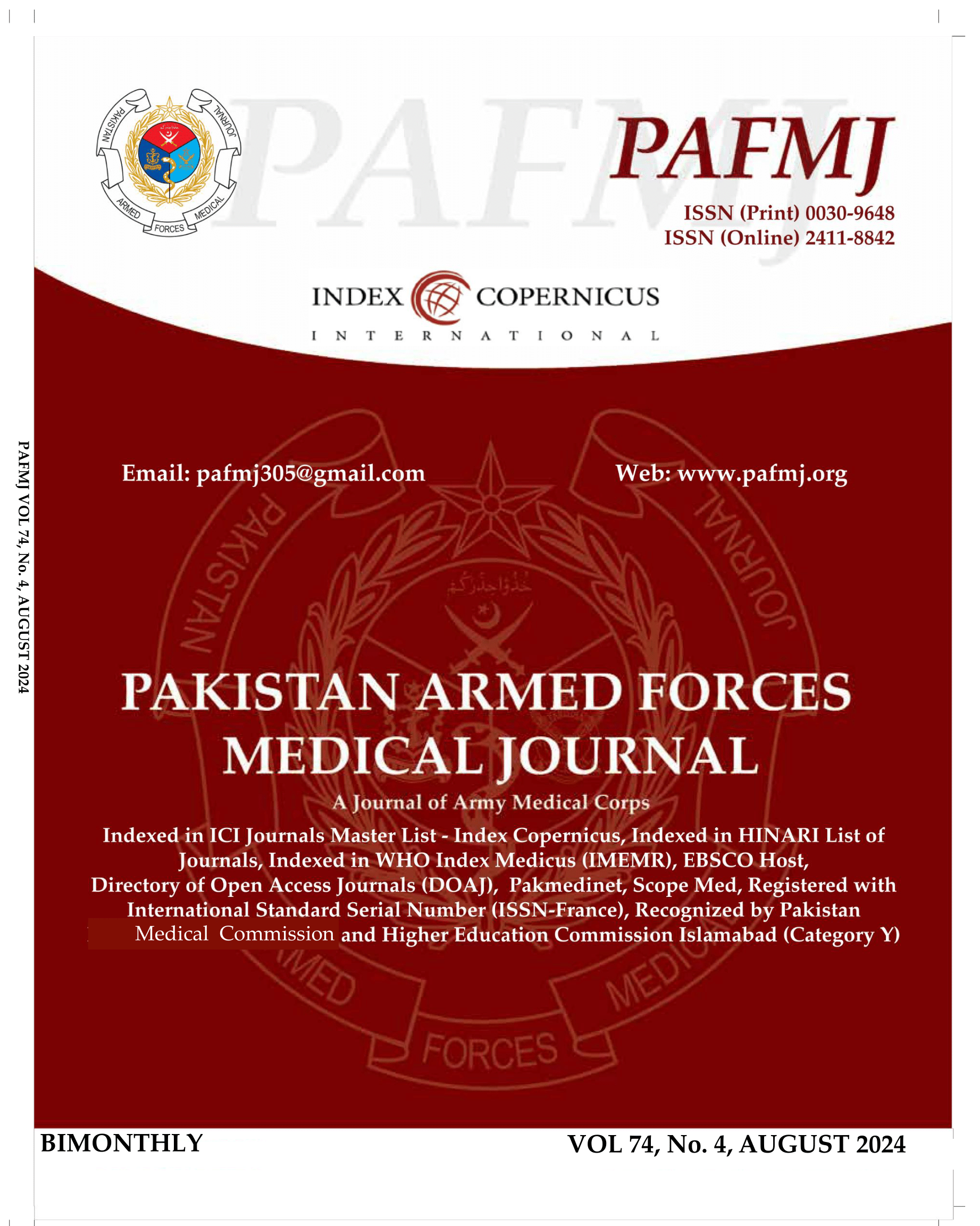Immunization Status of Children in Urban Slums of Rawalpindi and Barriers to Immunization
DOI:
https://doi.org/10.51253/pafmj.v74i4.7959Keywords:
: Communicable Diseases, immunization coverage, slums.Abstract
Objective: To determine immunization status of children residing in urban slums of Rawalpindi and identify the barriers to immunization.
Study Design: Cross sectional study.
Place and Duration of Study: Slums of Takht Pari, Rawalpindi Pakistan, from Jan to Mar 2020.
Methodology: Children, aged 12-23 months, residing at Takht Pari were enrolled. Two sessions of a free medical camp were arranged at Takht Pari by Department of Community Medicine, Foundation University, Islamabad. Data was collected from parents visiting the medical camp with the mother labelled as the primary respondent. Immunization cards and mother’s recall were used to assess the immunization status of children.
Results: Two hundred ninety-one (72.9%) children were completely immunized, partially immunized were 106(26.6%) while 2(0.5%) were unimmunized. Three hundred eighty-eight (97.2%) children were vaccinated through government centers while those who received vaccination through private clinics were 9(2.3%). Factors associated with incomplete immunization were education of parents (p<0.001), number of children (p<0.001), gender of child (p=0.001), access to TV or Radio (p<0.001), and site of immunization (government/private) (p<0.001).
Conclusion: Immunization status of 73% shows that unremitting efforts are essential for attaining universal coverage of immunization with extra attention to underprivileged areas. Planning and placement of public facilities for preventive services needs to be an urgent priority improving service utilization and enhancing coverage as people tend to follow ease of accessibility for using immunization services.
Downloads
References
Singh CM, Mishra A, Agarwal N, Mishra S, Lohani P, Ayub A. Immunization coverage among children aged 12-23 months: A cross-sectional study in low-performing blocks of Bihar, India. J Family Med Prim Care 2019; 8(12): 3949-3955.
https://doi.org/10.4103/jfmpc.jfmpc_830_19
Bangura JB, Xiao S, Qiu D, Ouyang F. Barriers to childhood immunization in sub-Saharan Africa: A systematic review. BMC Public Health 2020; 20(1): 1108. https://doi.org/10.1186/s12889-020-09169-4
Golding N, Burstein R, Longbottom J, Browne AJ, Fullman N, Osgood-Zimmerman A, et al. Mapping under-5 and neonatal mortality in Africa, 2000-15, a baseline analysis for the Sustainable Development Goals. Lancet 2017; 390: 2171-2182. https://doi.org/10.1016/S0140-6736(17)31758-0
Orenstein WA, Douglas RG, Rodewald LE, Hinman AR. Immunizations in the United States: success, structure, and stress. Health Aff 2005; 24(3): 599-610.
https://doi.org/10.1377/hlthaff.24.3.599
Mina MJ. Measles, immune suppression, and vaccination: direct and indirect nonspecific vaccine benefits. J Infect 2017; 74(1): 10-17. https://doi.org/10.1016/j.jinf.2016.09.004
Shukla VV, Shah RC. Vaccinations in primary care. Indian J Pediatr 2018; 85(12): 1118-1127. https://doi.org/10.1007/s12098-018-2710-3
Riley LW, Ko AI, Unger A, Reis MG. Slum health: diseases of neglected populations. BMC Int Health Hum Rights 2007; 7(2). https://doi.org/10.1186/1472-698X-7-2
Shaikh BT, Haq ZU, Tran N, Hafeez A. Health system barriers and levers in implementation of the Expanded Programme on Immunization (EPI) in Pakistan: an evidence-informed situation analysis. Public Health Rev 2018; 39: 24.
https://doi.org/10.1186/s40985-018-0103-x
Din M, Ali H, Khan M, Waris A, Ullah S, Kashif M, et al. Impact of COVID-19 on polio vaccinations in Pakistan: a concise overview. Rev Med Virol 2021; 31(4): e2190.
https://doi.org/10.1002/rmv.2190
Sreevatsava M, Burman AL, Wahdan A, Safdar RM, O'Leary A, Amjad R, et al. Routine immunization coverage in Pakistan: a survey of children under 1 year of age in community-based vaccination areas. Vaccine 2020; 38(28): 4399-4404.
https://doi.org/10.1016/j.vaccine.2020.04.067
Adedire EB, Ajayi I, Fawole OI, Ajumobi O, Kasasa S, Wasswa P, et al. Immunisation coverage and its determinants among children aged 12-23 months in Atakumosa-West District, Osun State, Nigeria: a cross-sectional study. BMC Public Health 2016; 16(1): 905. https://doi.org/10.1186/s12889-016-3549-8
Khan A, Khan S, Ullah I, Yaseen S, Khan G, Rashid H, et al. Evaluation of immunization coverage in the rural area of Peshawar, Khyber Pakhtunkhwa. Cureus 2019; 11(1): e3992. https://doi.org/10.7759/cureus.3992
Naeem M, Khan MZ, Adil M, Abbas SH, Khan MU, Khan A, et al. Inequity in childhood immunization between urban and rural areas of Peshawar. J Ayub Med Coll 2011; 23(3): 134-137.
Shaikh BT. Strengthening health system building blocks: configuring post COVID-19 scenario in Pakistan. Prim Health Care Res Dev 2021; 22: e9.
https://doi.org/10.1017/S1463423621000092
Bukhari HT, Ibrahim M, Bukhari KT, Zafar H. A systematic review to identify the factors for partial vaccination in children. J Islamabad Med Dental Coll 2016; 5(1): 45-47.
Smith LE, Amlot R, Weinman J, Yiend J, Rubin GJ. A systematic review of factors affecting vaccine uptake in young children. Vaccine 2017; 35(45): 6059-6069.
https://doi.org/10.1016/j.vaccine.2017.09.046
Yang R, Penders B, Horstman K. Vaccine hesitancy in China: A qualitative study of stakeholder's perspectives. Vaccines 2020; 8(4): 650. https://doi.org/10.3390/vaccines8040650
Bhuiya A, Bhuiya I, Chowdhury M. Factors affecting acceptance of immunization among children in rural Bangladesh. Health Policy Plan 1995; 10(3): 304-312.
https://doi.org/10.1093/heapol/10.3.304
Machingaidze S, Rehfuess E, von Kries R, Hussey GD, Wiysonge CS. Understanding interventions for improving routine immunization coverage in children in low and middle-income countries: a systematic review protocol. Syst Rev 2013; 2:106. https://doi.org/10.1186/2046-4053-2-106
Downloads
Published
Issue
Section
License
Copyright (c) 2024 Nazish Khan, Naila Azam, Syed Fawad Mashhadi, Qaisar Javed, Mehwish Riaz, Fatima Ali Raza Mughal, Sana Iqbal

This work is licensed under a Creative Commons Attribution-NonCommercial 4.0 International License.















